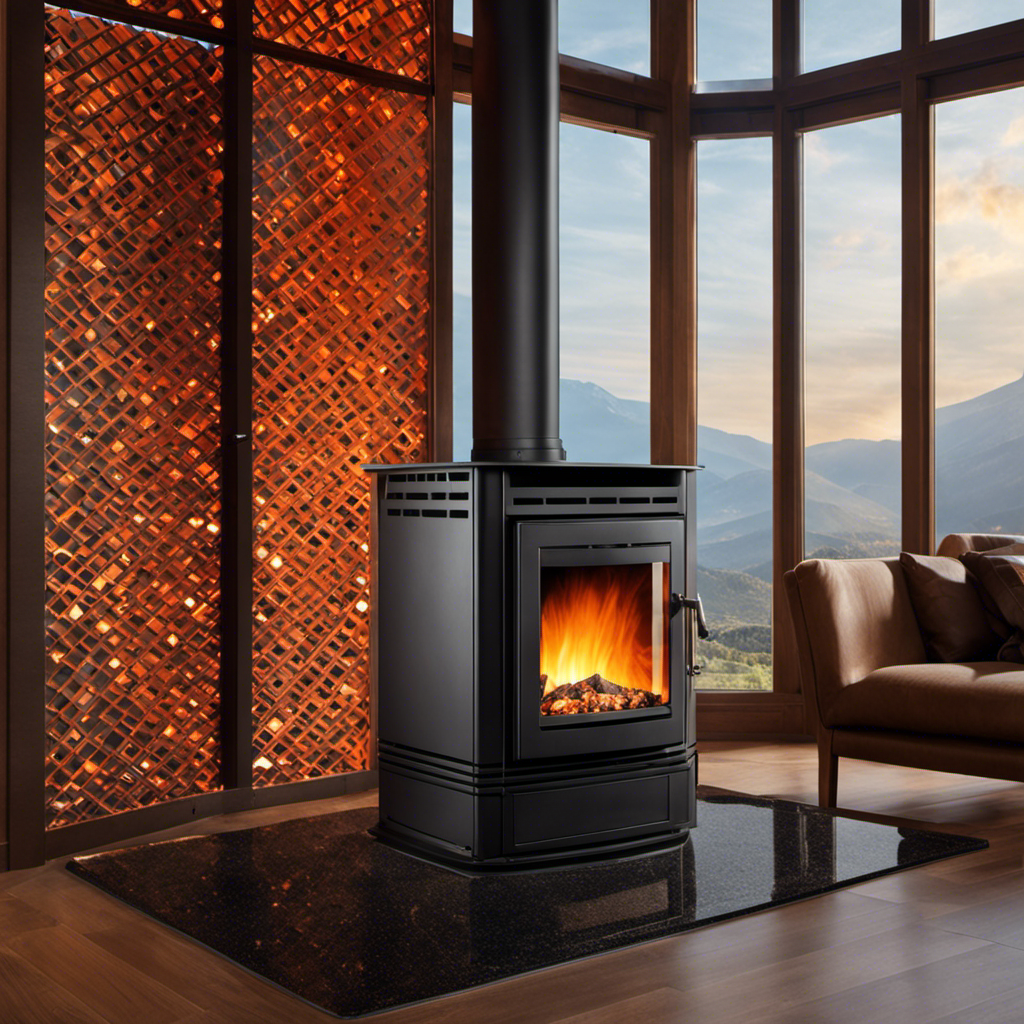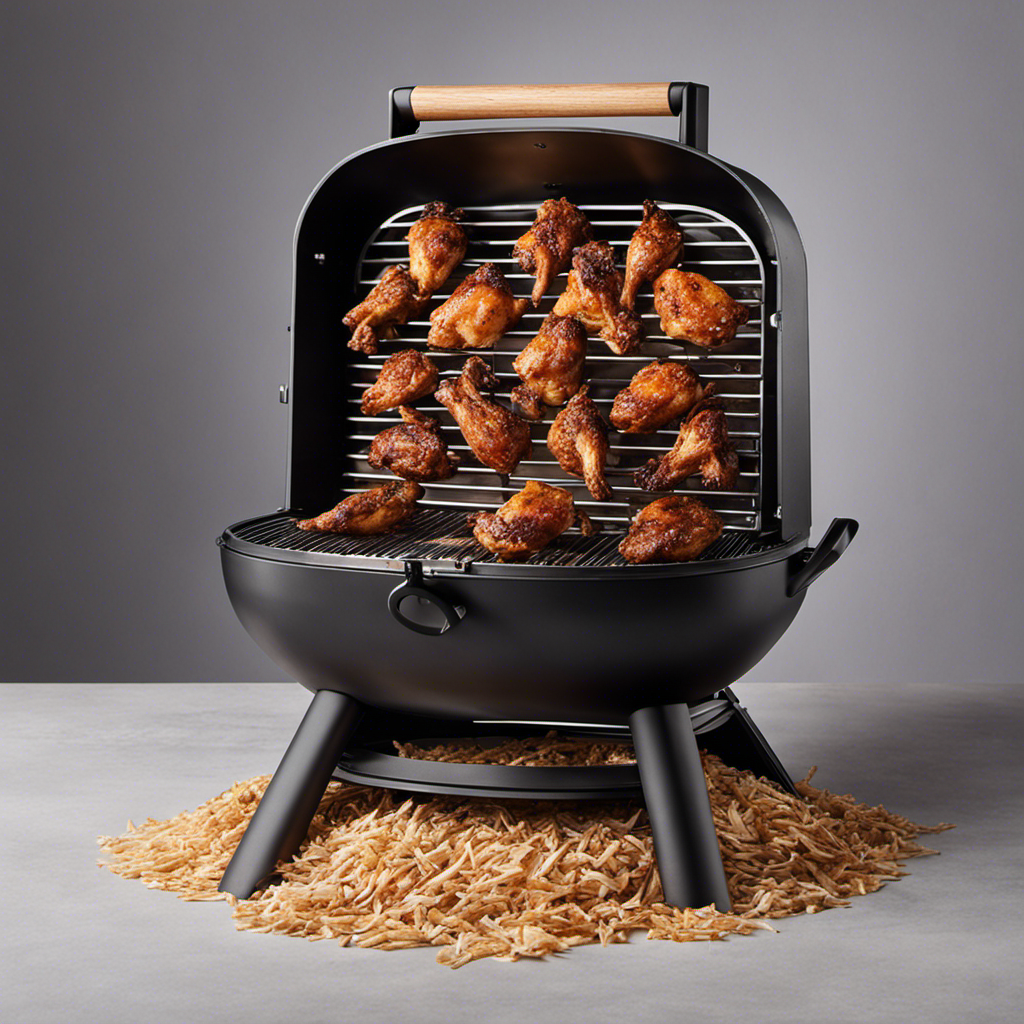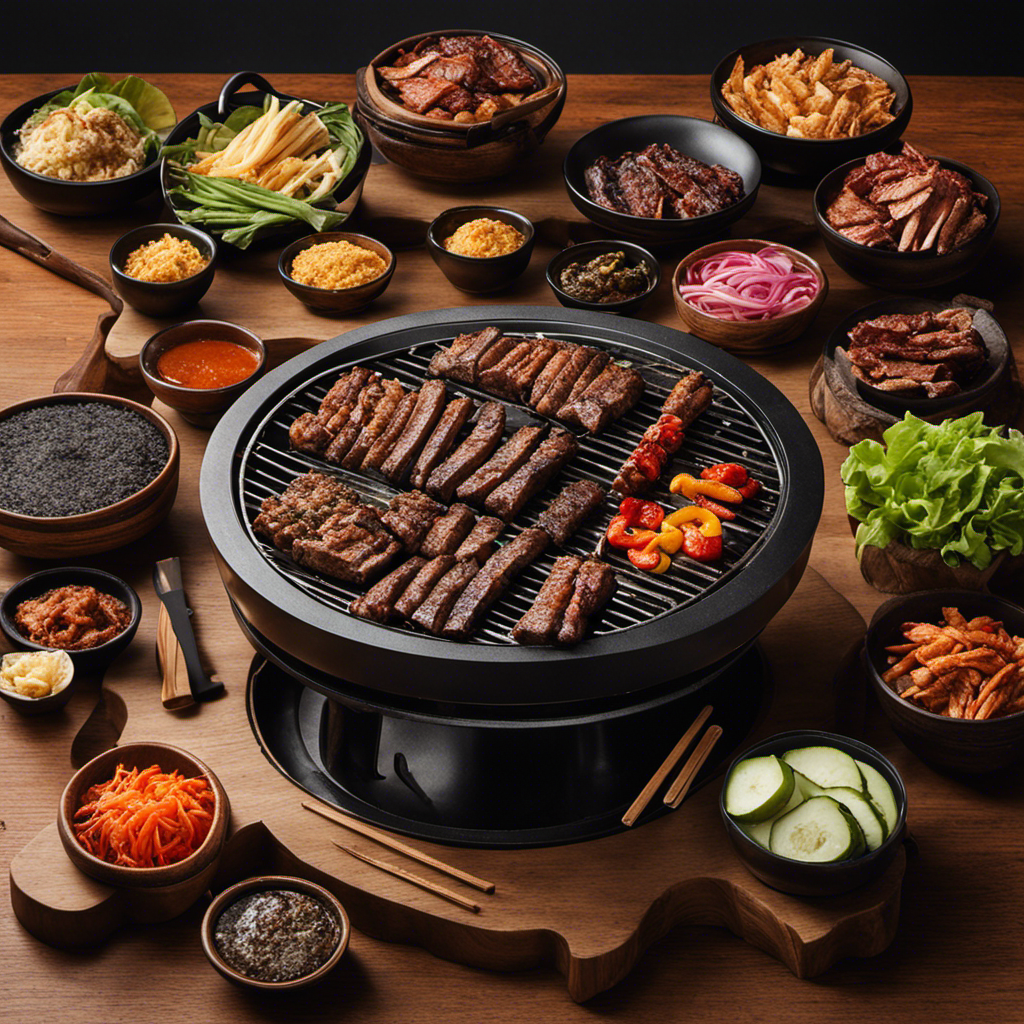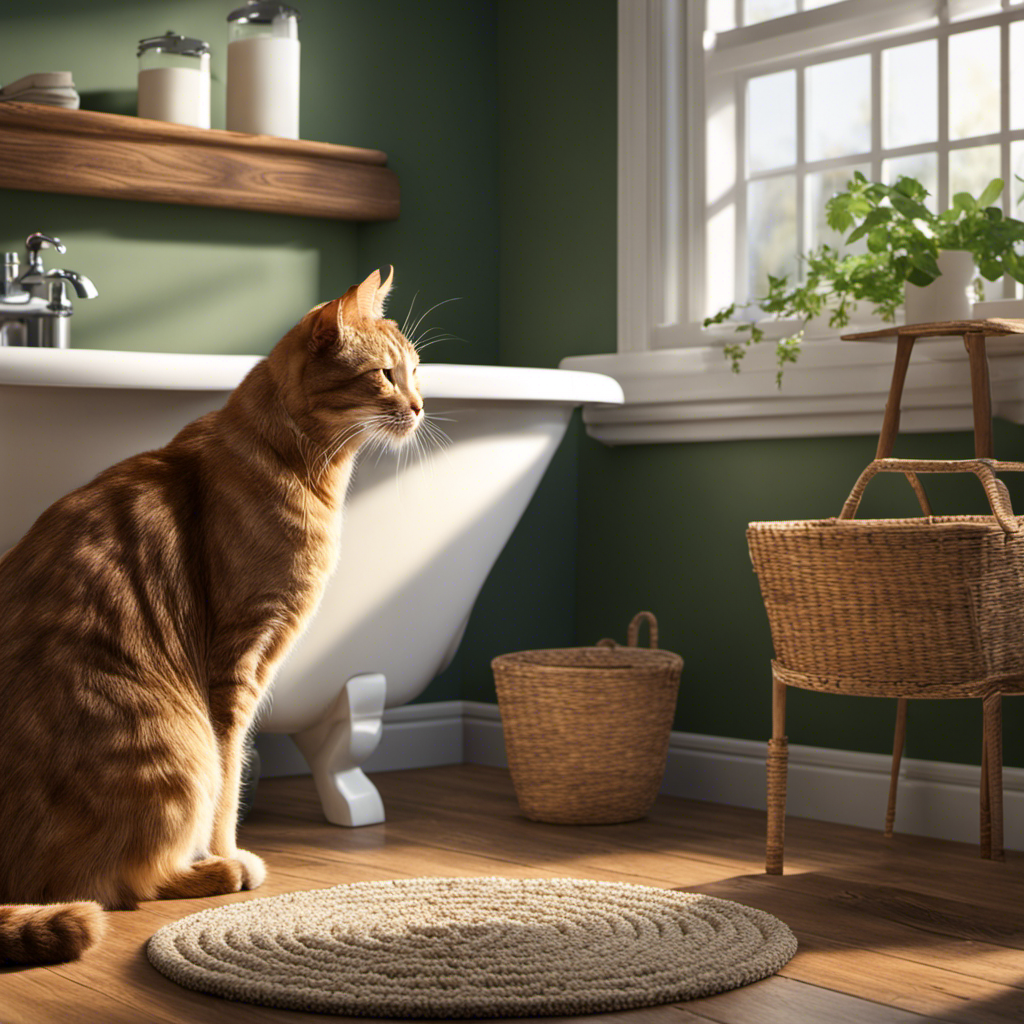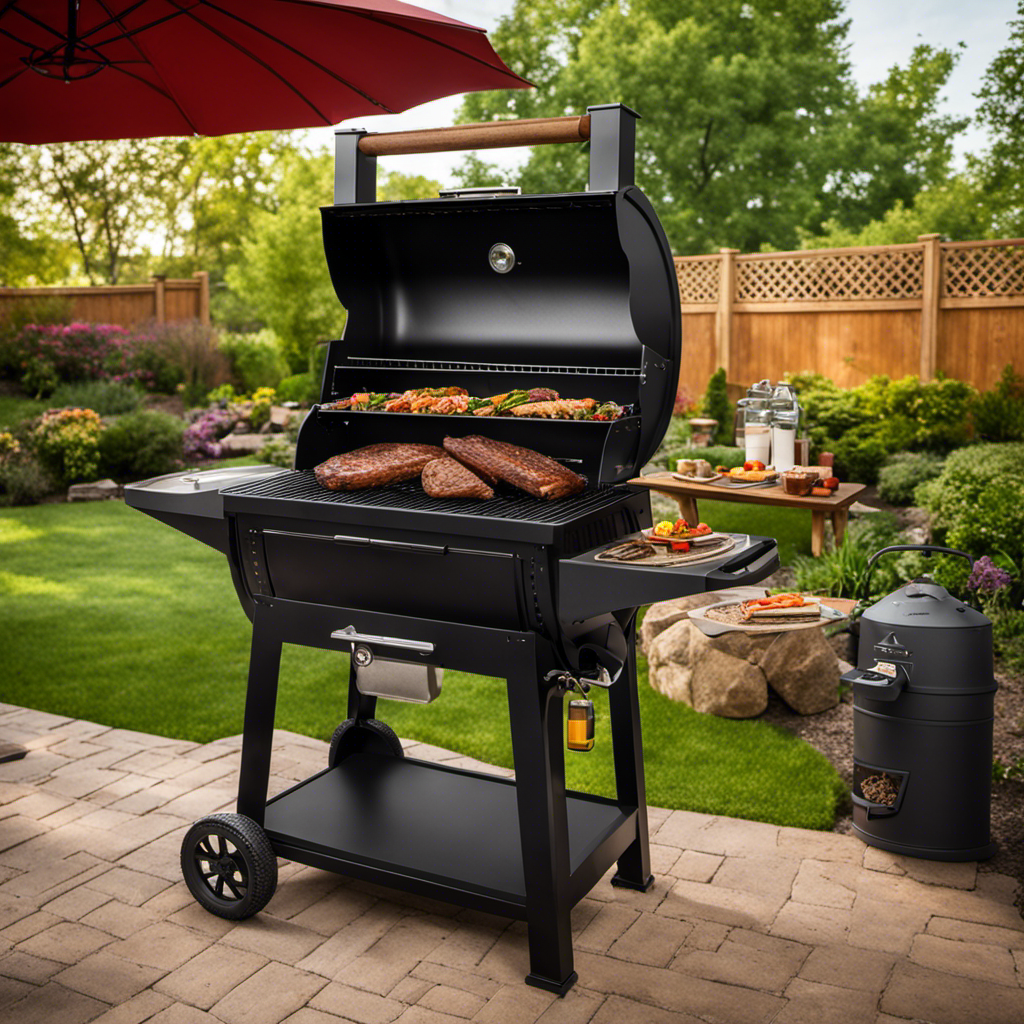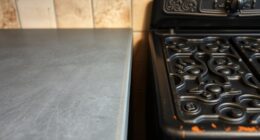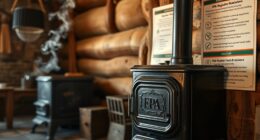Looking to maximize your pellet stove’s efficiency? Look no further, because we have all the solutions you’re seeking!
In this article, we’ll delve into the secrets of optimal pellet stove performance, sharing expert tips and tricks to maximize efficiency.
From regular maintenance and cleaning to adjusting air induction and experimenting with different pellet types, we’ve got you covered.
So, let’s dive in and unlock the secrets to an exceptional pellet stove experience!
Key Takeaways
- Regularly clean and maintain the pellet stove, including removable filters, to ensure optimal performance.
- Experiment with different types of pellets to find the best fit for your home setup and maximize heat output.
- Understanding pellet production and how to make them at home can be beneficial in optimizing pellet stove performance.
- Keep the hopper filled with high-quality pellets and schedule professional maintenance to prevent common issues and ensure efficient operation.
The Importance of Regular Cleaning and Maintenance
Regular cleaning and maintenance of pellet stoves is crucial for ensuring optimal performance and longevity. To help you stay on top of these tasks, here is a pellet stove maintenance checklist to follow.
First, gather the necessary cleaning tools and techniques. You’ll need a brush with stiff bristles, a vacuum cleaner, a crevice tool attachment, and a damp cloth. Start by turning off the stove and allowing it to cool completely before beginning any cleaning.
Next, remove the ash and clean the burn pot. Use the brush to remove any ash buildup and vacuum out the remaining debris. Wipe down the glass door with a damp cloth to remove any soot or residue.
Check and clean the exhaust vent regularly to ensure proper airflow. Use the crevice tool attachment on your vacuum cleaner to remove any debris or obstructions.
Lastly, schedule professional maintenance at least once a year to ensure that all components are in good working condition.
Enhancing Heat Output With Air Induction and Positioning
To enhance the heat output of our pellet stove, we can improve air induction and adjust its positioning for better oxygen flow and heat distribution.
Improving air circulation is crucial in maximizing the efficiency of a pellet stove. By ensuring proper air induction, we can enhance the combustion process and increase the heat output. This can be achieved by installing a small metal fan to increase the airflow.
Additionally, adjusting the stove’s positioning can also contribute to better heat distribution. Placing the stove in a central location within the room allows for more even heat distribution throughout the space.
Finding the Perfect Pellet: Types and Considerations
When it comes to finding the perfect pellet for our pellet stove, we need to consider various types and factors. Pellet selection criteria play a crucial role in ensuring optimal performance and efficiency.
It’s important to compare pellet stove brands and understand the differences in the pellets they recommend. Factors such as pellet composition, moisture content, and ash content should be taken into account. High-quality pellets should have low moisture and ash content, ensuring cleaner burning and minimal maintenance.
Additionally, considering the source of the pellets, whether they’re made from recycled materials or organic sources, can also impact their performance.
DIY Pellet Production: A Homeowner’s Guide
By understanding the process of DIY pellet production, we can save money and create our own fuel for our pellet stoves. DIY pellet production offers cost-effective solutions and allows us to have control over the quality of the pellets we use. Here is a table that breaks down the DIY pellet production process:
| Steps | Materials |
|---|---|
| 1. Collect wood waste or organic materials | – Wood chips – Dried leaves – Mulched trees – Other backyard materials |
| 2. Dry the materials thoroughly | – Air drying – Use a dehydrator or oven |
| 3. Grind the materials into fine particles | – Wood chipper or grinder – Blender or food processor |
| 4. Add a binder (optional) | – Lignin-based binder – Vegetable oil |
| 5. Compress the mixture into pellets | – Pellet press – Pellet mill |
| 6. Allow the pellets to cool and harden | – Cooling rack or tray – Room temperature |
| 7. Store the pellets in a dry, airtight container | – Plastic bags – Sealed bins |
In addition to DIY pellet production, proper pellet stove maintenance is crucial for optimal performance. Here are some troubleshooting tips:
- Regularly clean the pellet stove and filters.
- Install a small metal fan for increased air induction and heat output.
- Adjust the stove’s positioning to improve oxygen flow and heat distribution.
- Experiment with different types of pellets to find the best fit for your home setup.
- Schedule professional maintenance to ensure the stove is in good working condition.
- Use high-quality pellets to prevent issues such as auger jams and igniter failure.
- Keep the hopper filled with pellets for consistent and efficient burning.
Troubleshooting Common Pellet Stove Issues
Understanding the common issues and troubleshooting methods for pellet stoves can help us maintain their efficiency and functionality. When faced with problems such as a malfunctioning igniter or a jammed auger, here are three steps to address the issues:
-
Troubleshooting the pellet stove igniter:
- Check if the igniter is properly connected and positioned.
- Inspect the igniter for any signs of damage or wear.
- Clean the igniter and surrounding area to ensure proper ignition.
-
Addressing pellet stove auger jams:
- Turn off the stove and unplug it from the power source.
- Remove any pellets or debris that may be causing the jam.
- Inspect the auger for any damage and lubricate it if necessary.
Comparing Pellet Stoves and Kerosene Heaters
When comparing pellet stoves and kerosene heaters, there are several factors to consider, including portability benefits and cost comparison.
| Pellet Stoves | Kerosene Heaters | |
|---|---|---|
| Portability Benefits | Pellet stoves are not typically portable since they require electricity to operate. They are designed to be installed in a specific location, such as a living room or basement. | Kerosene heaters, on the other hand, are portable and can be easily moved from room to room or taken outdoors. They do not require electricity to operate, making them convenient for use in areas without power sources. |
| Cost Comparison | When it comes to fuel cost, pellet stoves generally have a lower cost compared to kerosene heaters. Wood pellets used in pellet stoves are often made from recycled materials or organic substances, making them more affordable and environmentally friendly. Kerosene, on the other hand, can be more expensive and may require frequent refills. Additionally, pellet stoves tend to be more energy-efficient, resulting in lower overall heating costs. |
Overall, while pellet stoves offer efficient and cost-effective heating, kerosene heaters provide the flexibility of portability. It’s important to consider your specific needs and preferences when deciding between the two options.
Understanding the Energy Efficiency of Pellet Stoves
One thing we should consider is the energy efficiency of pellet stoves compared to other heating options. Understanding the energy efficiency of pellet stoves is essential for improving their performance and maximizing heat distribution. Here are three key factors to consider:
-
Insulation: Properly insulating your home can significantly improve the energy efficiency of your pellet stove. Ensure that windows and doors are properly sealed to prevent heat loss.
-
Heat Distribution: To optimize heat distribution, position your pellet stove in a central location. This allows the heat to evenly spread throughout the room or house, reducing the need for additional heating sources.
-
Regular Maintenance: Regularly cleaning and maintaining your pellet stove ensures its efficiency. Remove any ash buildup and clean the exhaust vent to improve airflow and heat distribution.
The Environmental Benefits of Pellet Stoves
We can’t overlook the fact that pellet stoves offer significant environmental benefits, such as reducing smoke pollution and recycling wood waste.
Pellet stoves are a great option for improving indoor air quality. Unlike traditional wood stoves, pellet stoves burn wood pellets that produce minimal smoke and emissions. This means less pollution and cleaner air inside your home.
Additionally, pellet stoves are cost-effective for heating. Wood pellets are made from recycled wood waste, which is an affordable and sustainable fuel source. Moreover, pellet stoves are highly efficient and can heat a room quickly and effectively. This not only saves on heating costs but also provides a cozy and comfortable environment.
Optimizing Pellet Stove Performance: Tips and Tricks
To get the most out of our pellet stove, we should regularly clean it, adjust its positioning for better heat distribution, and experiment with different types of pellets. Here are some tips and tricks for optimizing pellet stove performance:
-
Clean the stove: Regularly clean the pellet stove, including removable filters, to ensure proper airflow and prevent clogs. This will help maintain efficient combustion and heat output.
-
Adjust positioning: Position the stove in a central location to evenly distribute heat throughout the room. Avoid placing it near drafts or in corners, as this can disrupt airflow and reduce heat effectiveness.
-
Experiment with pellets: Different types of pellets can vary in burn rate and heat output. Try using different brands or blends to find the ones that work best for your stove and heating needs.
The Role of Wood Pellets in Pellet Stove Performance
Wood pellets play a crucial role in how efficiently our pellet stove operates, ensuring consistent heat distribution and optimal performance. Made from recycled wood waste, wood pellets are an eco-friendly fuel source that offers numerous benefits. They are cost-effective to produce and can be made from recycled materials, reducing environmental waste. Additionally, wood pellets burn cleaner than regular wood, producing less smoke pollution and ash. This not only benefits the environment but also reduces the maintenance required for the pellet stove. Furthermore, wood pellets have a higher energy density than regular wood, meaning they burn more efficiently and provide longer-lasting heat. By using wood pellets in our pellet stove, we can enjoy the benefits of sustainable fuel and maximize the performance of our heating system.
| Benefits of Using Wood Pellets |
|---|
| Eco-friendly and sustainable |
| Cost-effective |
| Cleaner burning and less ash |
Professional Maintenance: When and Why It’s Necessary
When our pellet stove requires professional maintenance, it’s important to schedule it at the recommended intervals to ensure its proper functioning and longevity. Hiring professionals for pellet stove maintenance offers several benefits:
-
Expertise: Professionals have the knowledge and experience to identify and address any issues with the stove efficiently and effectively.
-
Safety: Pellet stoves involve electrical and combustion systems, so having professionals handle the maintenance reduces the risk of accidents or damage.
-
Cost-effectiveness: Regular professional maintenance can actually save money in the long run. It helps prevent major breakdowns and extends the lifespan of the stove, reducing the need for costly repairs or replacements.
The Impact of High-Quality Pellets on Performance
Using high-quality pellets in our stove significantly improves its efficiency and effectiveness.
The benefits of using organic pellets are numerous. Organic pellets are made from dried leaves, mulched trees, or other backyard materials, making them an environmentally friendly option. They burn cleaner, producing less smoke pollution and ash compared to regular wood pellets. Additionally, organic pellets recycle materials that would otherwise be thrown away, reducing waste.
Regular maintenance also plays a crucial role in optimizing pellet stove performance. By regularly cleaning the stove, checking and cleaning the exhaust vent, and scheduling professional maintenance, we can ensure that our stove operates at its best.
Furthermore, understanding the impact of pellet stove maintenance on performance helps us identify common issues such as auger jams, igniter failure, and poor quality fuel, allowing us to address them promptly and maintain efficient stove operation.
Maximizing Longevity: Proper Care and Storage of Pellets
Now that we understand the importance of using high-quality pellets for optimal performance in pellet stoves, it’s crucial to discuss proper care and storage techniques to prevent pellet degradation. Here are some key tips to help you maximize the longevity of your pellets:
-
Keep them in a dry and cool environment: Moisture is the enemy of pellets as it can cause them to break down and lose their effectiveness. Make sure to store your pellets in a dry area away from any sources of humidity or water.
-
Use airtight containers: To further protect your pellets from moisture, consider using airtight containers or bags to store them. This will help maintain their quality and prevent any moisture from seeping in.
-
Avoid exposure to sunlight: Sunlight can also contribute to the degradation of pellets, so it’s important to store them in a place where they’re shielded from direct sunlight.
Frequently Asked Questions
Can Pellet Stoves Be Used Without Electricity?
Yes, pellet stoves can be used without electricity. They’re an excellent alternative heating option for off-grid situations.
While pellet stoves typically require electricity to operate, there are models available that have battery backup or can be manually started. These off-grid options allow you to enjoy the benefits of pellet stoves even in areas without access to electrical power.
It’s important to consider these alternatives when looking for off-grid heating solutions.
What Are the Benefits of Using Organic Pellets?
Using organic pellets in pellet stoves offers numerous benefits.
Firstly, they promote sustainability by utilizing backyard materials and dried leaves, reducing waste.
Secondly, organic pellets burn cleanly, producing minimal smoke and ash. This not only improves air quality but also reduces the need for frequent stove cleaning.
Lastly, organic pellets can add a unique flavor to home-cooked meals, making them a versatile option for those who enjoy cooking.
Overall, the use of organic pellets in pellet stoves contributes to a more environmentally friendly and flavorful heating experience.
How Can I Troubleshoot Auger Jams in My Pellet Stove?
When troubleshooting burn issues in our pellet stove, we can start by addressing auger maintenance. Regular cleaning and lubricating the auger can help prevent jams.
It’s important to check for any obstructions and remove them carefully.
If the issue persists, we may need to inspect the auger motor and replace it if necessary.
Additionally, ensuring that we’re using high-quality pellets and following proper maintenance procedures can help optimize the performance of our pellet stove.
Are There Any Safety Concerns When Producing Pellets at Home?
When it comes to home pellet production, safety is a top priority. While making your own pellets can be a cost-effective option, it’s essential to take precautions. Proper ventilation and fire safety measures are crucial to prevent accidents.
It’s also important to ensure that the materials used to make the pellets are safe and free from contaminants. Following guidelines and using appropriate equipment can help maintain a safe environment during the pellet production process.
What Is the Impact of Using Low-Quality Pellets on Pellet Stove Performance?
The impact of using low-quality pellets on pellet stove performance can be significant. Subpar pellets may burn less efficiently, leading to reduced heat output and increased fuel consumption. They can also cause more ash and soot buildup, requiring more frequent cleaning and maintenance.
It’s important to prioritize pellet quality for optimal performance. High-quality pellets ensure efficient combustion, minimal ash production, and longer stove lifespan. By using top-notch pellets, you can maximize the efficiency and effectiveness of your pellet stove.
Conclusion
In conclusion, by following the tips and tricks provided in this article, you can unlock the secrets to optimal pellet stove performance.
Regular cleaning and maintenance, adjusting air induction, experimenting with different pellet types, and using high-quality pellets are all key factors in maximizing efficiency.
While some may argue that pellet stoves require more maintenance compared to other heating options, the benefits of cost-effectiveness, environmental friendliness, and efficient heat distribution outweigh any additional effort.
So, embrace the power of pellet stoves and enjoy a cozy and eco-friendly heating experience.
Growing up surrounded by the vast beauty of nature, Sierra was always drawn to the call of the wild. While others sought the comfort of the familiar, she ventured out, embracing the unpredictable and finding stories in the heartbeat of nature.
At the epicenter of every remarkable venture lies a dynamic team—a fusion of diverse talents, visions, and passions. The essence of Best Small Wood Stoves is crafted and refined by such a trio: Sierra, Logan, and Terra. Their collective expertise has transformed the platform into a leading authority on small wood stoves, radiating warmth and knowledge in equal measure.

